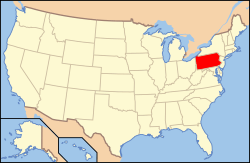Brewerytown, Philadelphia
Brewerytown is a neighborhood in the North Central Philadelphia district of the city of Philadelphia, Pennsylvania, United States. An unofficial region, Brewerytown runs approximately between the Schuylkill River's eastern bank and 25th Street, bounded by Cecil B. Moore Avenue to the north and Parrish Street to the south. Brewerytown got its name because of the numerous breweries that were located along the Schuylkill during the late 19th century and early 20th century.[2] It is now primarily a residential neighborhood, with a growing and active commercial sector along Girard Avenue.
Brewerytown Historic District | |
   | |
| Location | Roughly bounded by Cecil B Moore Ave., Pennsylvania Ave., 25th. and N. 33rd Philadelphia, Pennsylvania |
|---|---|
| Coordinates | 39°58′34″N 75°11′12″W |
| Area | 34.8 acres (14.1 ha) |
| Architect | William Decker et al. |
| Architectural style | Queen Anne, Other, Romanesque |
| NRHP reference No. | 91000096[1] |
| Added to NRHP | March 1, 1991 |
History
The earliest indications of this legacy can be seen on maps from the 1860s, which list several minor German brewers and distillation facilities in this region. Proximity to the river and nearby farmland allowed these establishments to flourish, and as demands increased, so did development in Brewerytown. By the early 20th century it was a thriving German settlement. Much of the expansion into the early 20th century was handled by architect Otto Wolf, who oversaw the construction of over 60 buildings in the area, bringing a distinct German texture to the houses, saloons, and breweries of the area. Some of his buildings are still standing, including the Bergdoll Brewing complex, and F.A. Poth Brewing. Jefferson Street Grounds, the first home of the Philadelphia Athletics major league baseball team and site of the first ever Major League Baseball game, is located at 27th and Jefferson Streets in the neighborhood. It was also home to famed Columbia Park.
At its peak, 700 breweries operated across Philadelphia, several in a ten-block area of Brewerytown. Unfortunately, with the collapse of local industry later in the 20th century, originally started by the implementation of Prohibition in the United States, and beer production moving primarily to the Midwest, every single brewer had vanished by 1987. The industry has slowly returned to the city, but at nowhere near the capacity of its heyday. As of 2016, the only active brewery in Brewerytown is Crime & Punishment Brewing, which opened in 2015. During this late 20th-century slump, the entirety of North Philadelphia, Brewerytown included, was hit hard by economic depressions. Much of the area was deemed blighted by the city government. In 1991, the Brewerytown Historic District was certified by the National Register of Historic Places. The district contains 380 buildings and is roughly bounded by Cecil B Moore Ave., Pennsylvania Ave., 25th. and N. 33rd.[3]
Breweries
Breweries that operated in the neighborhood included:[4]
- Bergner & Engel Brewing Company (Thompson Street between 32nd and 33rd, east side)
- Charles Eisner Brewery (Thompson Street between 32nd and 33rd, west side)
- F. A. Poth Brewing Company (31st & Jefferson Streets, NW corner)
- H. Mueller Centennial Brewery (31st & Jefferson Streets, NE corner)
- J. & P. Baltz Brewing Company (31st & Thompson Streets)
- Arnholt & Schaefer Brewing Company (31st and Thompson Streets, NE corner)
- G. Keller's Brewery (31st Street, west side, between Jefferson and Master)
- J. Bentz' Brewery (31st Street, west side, between Jefferson and Master)
- Thomas Perot Brewery (31st and Master Streets, NW corner)
- W. S. Perot (32nd and Thompson Streets, NW corner)
- Goldbeck & Eisele (31st and Thompson Streets, NE corner)
- Geo. F. Rothacker Brewery (31st Street, West side, between Thompson and Master)
- Eble & Herter (33rd Street and Pennsylvania Avenue)
- Francis Orth (later Burg & Pfaender, later Bergdoll Brewery; 33rd Street, south of Master Street)
- Henzler & Flach Brewery
- City Park Brewery (29th and Parrish Streets)
- Commonwealth Brewing Company (28th and Cambridge Streets)
- Keystone State Brewery (27th and Parrish Streets)
- Peter Schemm and Son (West College Ave. and Poplar Street)
- India Pale Ale Brewery (38th Street and Girard Avenue)
- Michel[5] Gosse (27th & Thompson Streets)
Transportation
SEPTA Route 15, a heritage streetcar line, runs through the neighborhood and connects to Girard Station on the Broad Street Line as well as the Market Frankford Line further east at Front Street. Bus Routes 48 and 49 also serve the area, traveling along North 29th Street between the Strawberry Mansion and Fairmount neighborhoods and crossing the Benjamin Franklin Parkway to and from Center City
See also
- Breweries in Philadelphia
References
- "National Register Information System". National Register of Historic Places. National Park Service. January 23, 2007.
- Thomas, George E. (1990). "Brewerytown" (PDF). National Register of Historic Places Nomination Form. Pennsylvania Historical and Museum Commission. Retrieved January 7, 2014.
- "National Register of Historical Places - PENNSYLVANIA (PA), Philadelphia County". Retrieved 13 February 2017.
- "Brewerytown" (PDF). National Register of Historic Places Inventory Form. Pennsylvania Historical and Museum Commission. 1990. Retrieved January 7, 2014.
- GreatGrandSon
External links
- Central Brewerytown Blight Recertification, City Planning Commission, 2005
- African-American Business & Residents Association
- Video Tour of Brewerytown
- Historic Photographs of Brewerytown, PhillyHistory.org
- Sound Space Performing Arts

